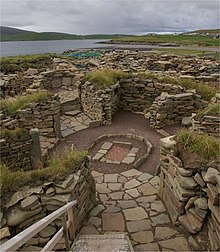Wheelhouse (archaeology)


In
Amateur enthusiasts did some excavation in the 19th century, but professional examination of the sites did not begin until the 1930s, when digs were undertaken at
Sometimes referred to as "aisled
Many sites incorporate animal burials beneath the floor, the most common bones being those of young lambs. Other bone deposits include the heads of a human and a great auk at Cnip on Lewis, and sixty bone burials including cattle, sheep and pig at Sollas in North Uist.[11] Five sites include menhirs and fifteen a red and black mortar. These features tends to support the hypothesis that the primary purpose of these buildings was ritualistic.[12] Confusingly therefore, "wheelhouses" are neither wheels, nor perhaps houses.[6]
The highly restricted nature of their geographical locations suggests that they may have been contained within a political or cultural frontier of some kind. The co-incidence of their arrival and departure being associated with the period of Roman influence in Scotland is a matter of ongoing debate.[13]
See also
Notes
- ^ The location has been lost. The discovery was by C. Gordon who reported it as being on a west shore "nearly level with the sea". It may have been on South Uist. See Crawford (2002) p. 113.
- ^ Armit, Ian, "Broch Building in Northern Scotland: The Context of Innovation" World Archaeology 21.3, Architectural Innovation (February 1990: 435–445).
- ^ Crawford (2002) p. 112.
- ^ The 8 presumed sites on Orkney are included in this total, although arguably there are none there. If this is the case a further conundrum as to the reason for their absence emerges. See Armit (2003) p. 135.
- ^ "Clettraval". Scotlands Places.
- ^ a b c Crawford (2002) p. 113.
- ^ Turner (1998) p. 81.
- ^ Crawford (2002) pp. 118–22.
- ^ Armit (2003) p. 136.
- ^ "Grimsay Wheelhouse". Alasdair McKenzie. 30 November 2009.
- ^ Armit (2003) p. 93.
- ^ Crawford (2002) pp. 123–4.
- ^ Crawford (2002) p. 128.
References
- Armit, Ian (February 1990). "Broch Building in Northern Scotland: The Context of Innovation". .
- Armit, (2003) Towers in the North: The Brochs of Scotland, Stroud : Tempus, ISBN 0-7524-1932-3
- Crawford, Iain "The wheelhouse" in Smith, Beverley Ballin and Banks, Iain (2002) In the Shadow of the Brochs. Stroud. Tempus. ISBN 0-7524-2517-X
- Turner, Val (1998) Ancient Shetland. London. B. T. Batsford/Historic Scotland. ISBN 0-7134-8000-9
